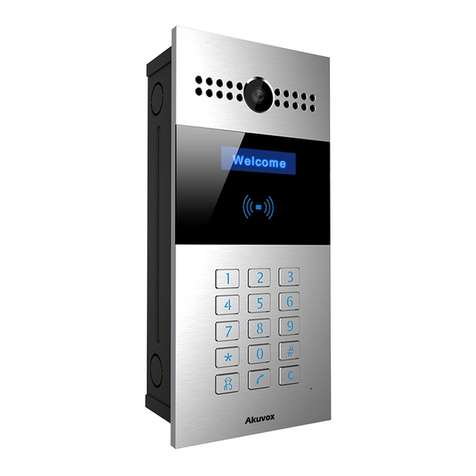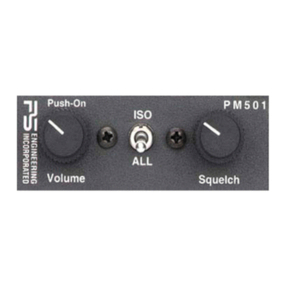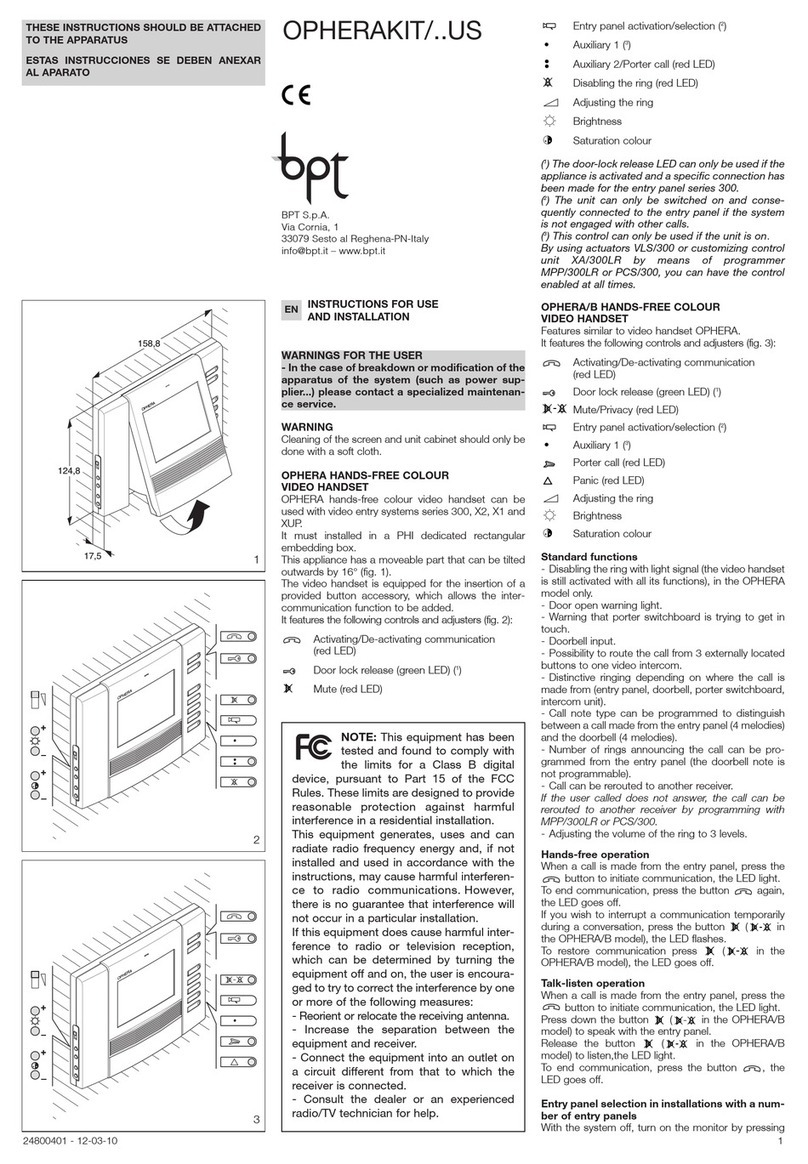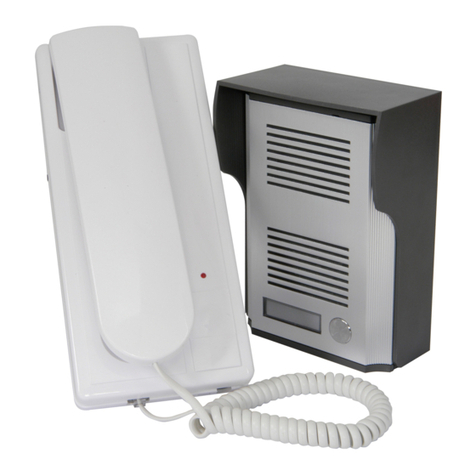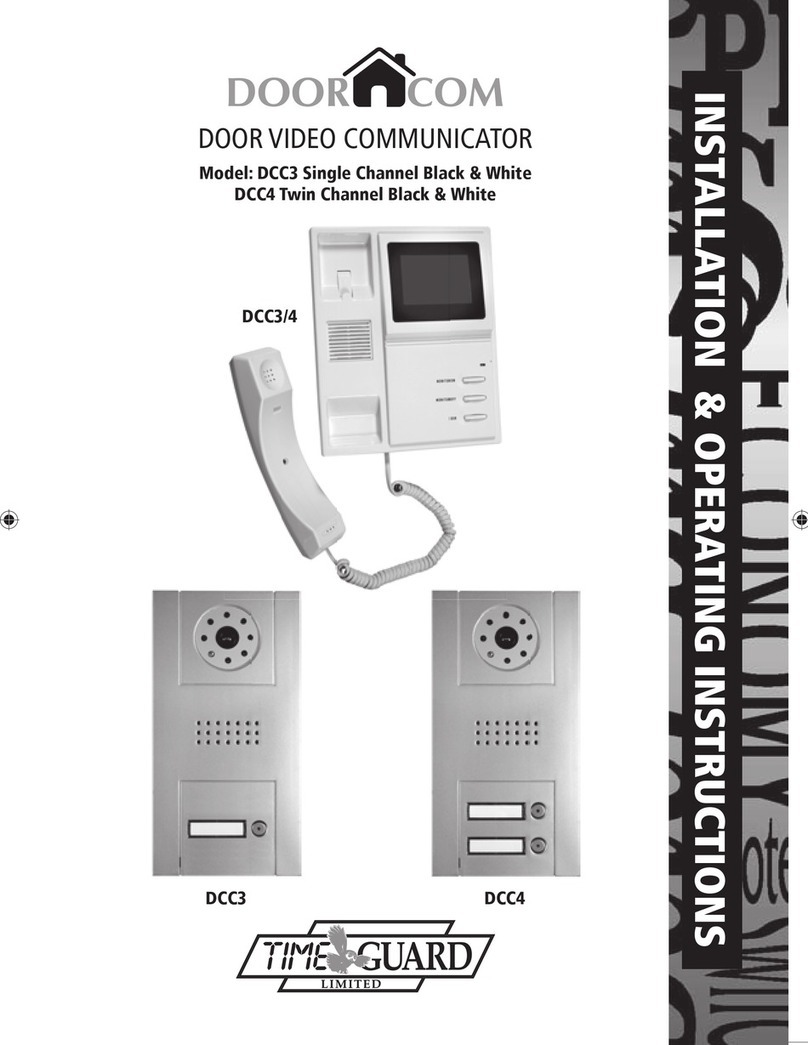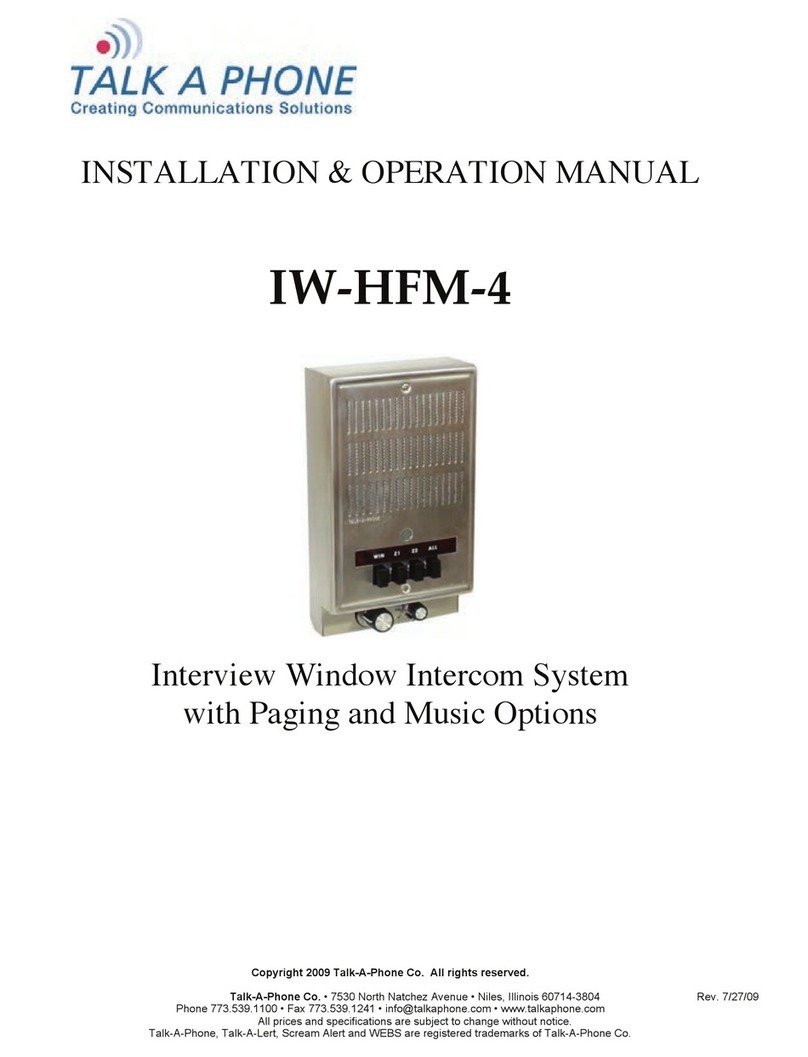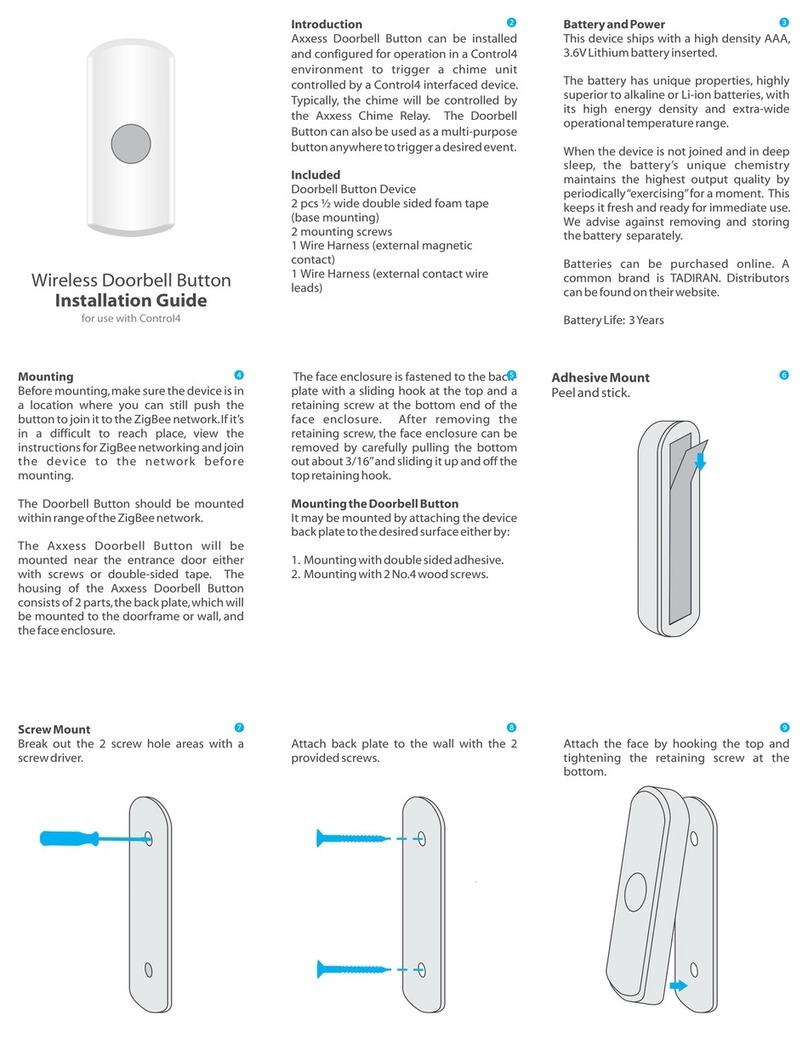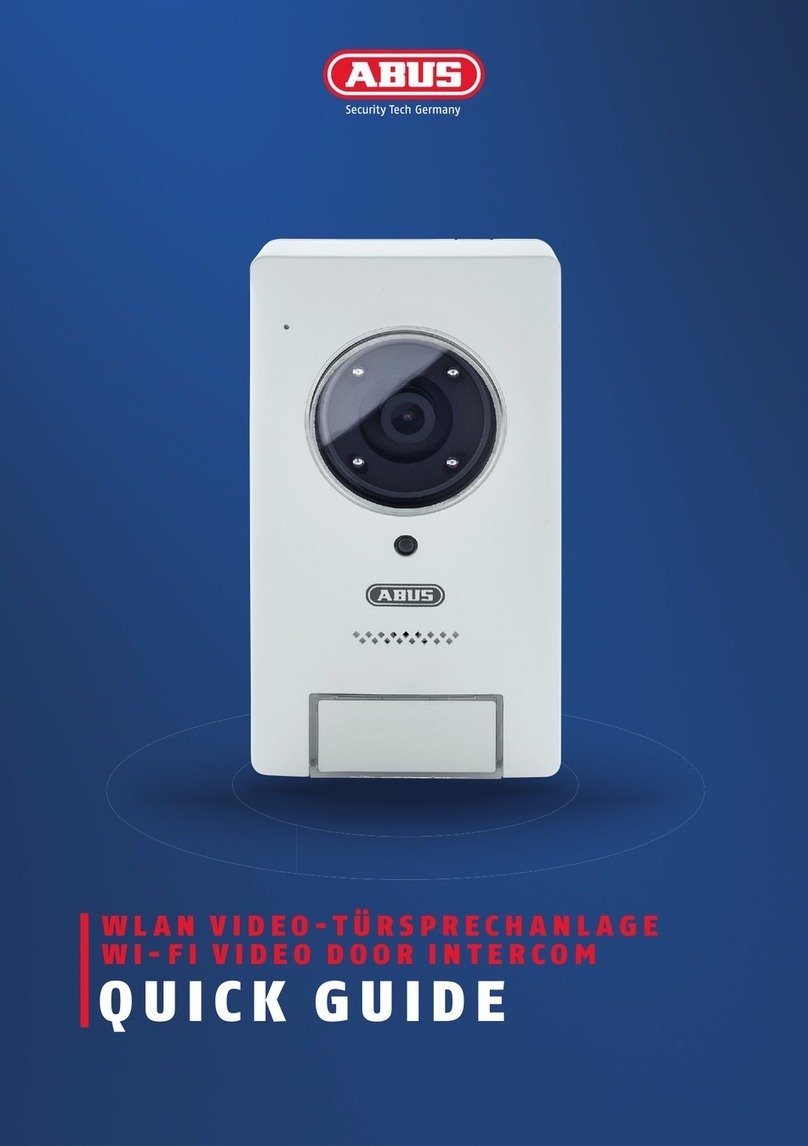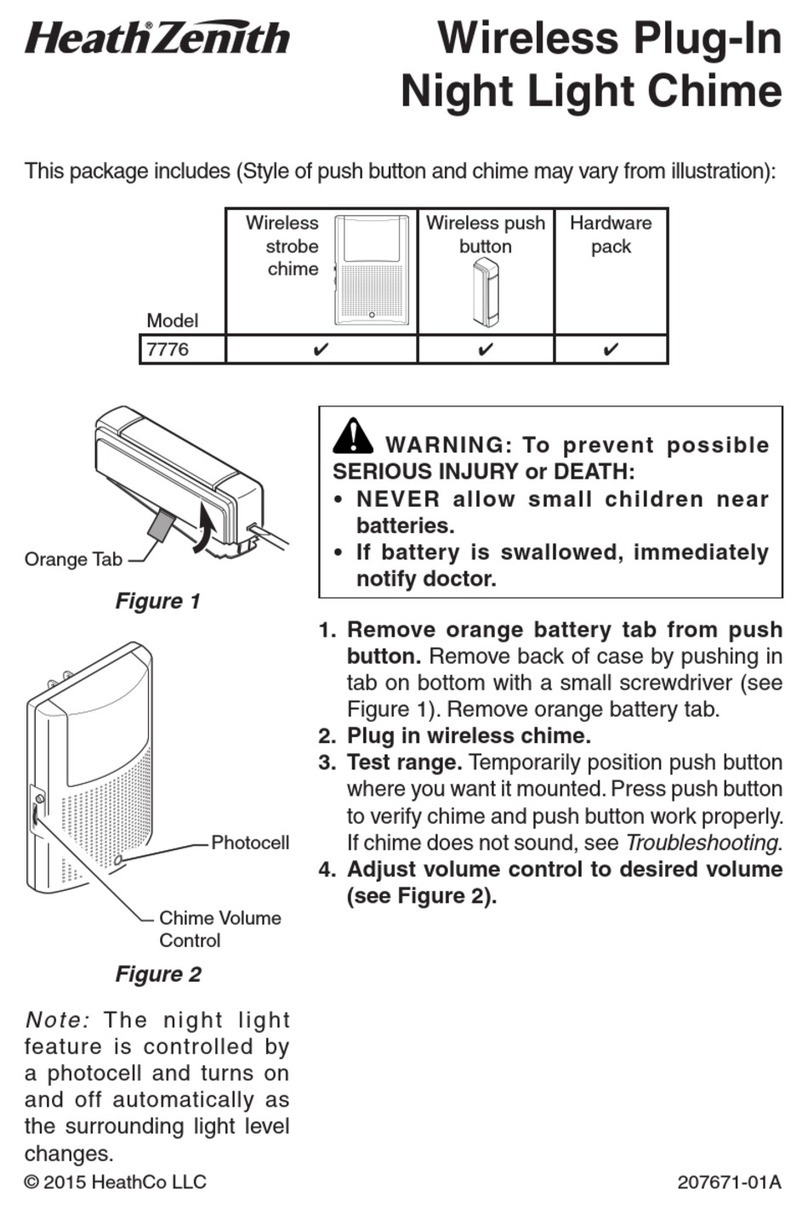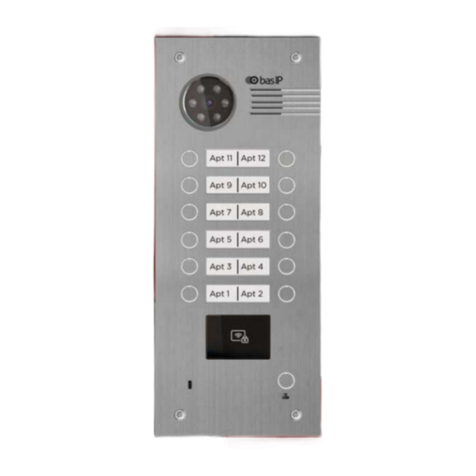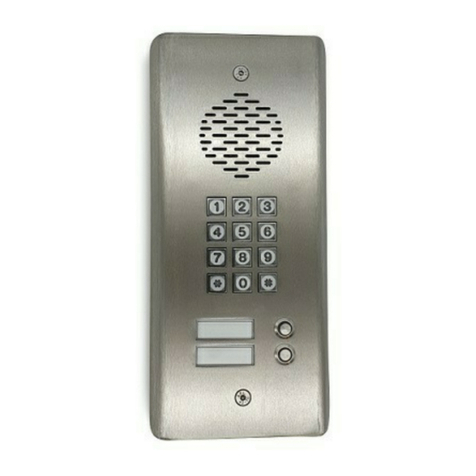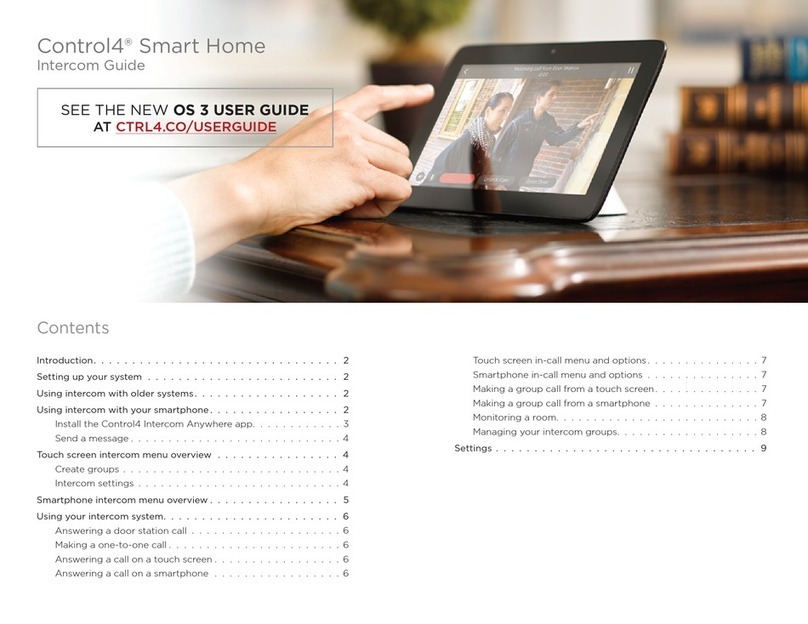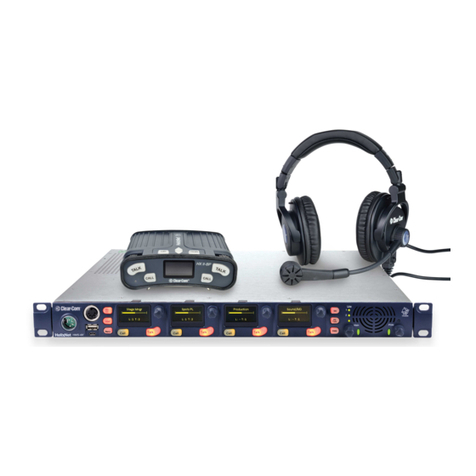SILENT KNIGHT 5084 User manual

Entry System
Part Number 151174D, 01/03
SILENT KNIGHT
5000 Series
Installation and
Operation Manual

151174 i
Content
Section 1
Overview ......................................................................................................................................................1-1
1.1 User Features ............................................................................................................................................ 1-1
1.2 What’s In the Box .................................................................................................................................... 1-2
1.3 About this Manual .................................................................................................................................... 1-2
1.3.1 Terminology ...................................................................................................................................... 1-2
Section 2
Telephone Requirements ...................................................................................................... 2-1
2.1 Before Connecting The Control Panel ..................................................................................................... 2-1
2.2 INDUSTRY CANADA WARNINGS .....................................................................................................2-2
2.2.1 AVIS D’INDUSTRIE CANADA ..................................................................................................... 2-3
Section 3
Installation Instructions ...........................................................................................................3-1
3.1 Model 5083/84 Parts ................................................................................................................................ 3-1
3.1.1 Keypad and LCD .............................................................................................................................. 3-1
3.1.2 Main Control Board .......................................................................................................................... 3-2
3.1.3 Main Control Board Components Description .................................................................................3-2
3.1.3.1 Main Power Switch ................................................................................................................3-2
3.1.3.2 Programming Dip Switch ....................................................................................................... 3-2
3.1.3.3 Battery Connector .................................................................................................................. 3-2
3.1.3.4 AC Power Input Terminals .................................................................................................... 3-3
3.1.3.5 Door and Auxiliary Relay Terminals .....................................................................................3-3
3.1.3.6 The Door and Auxiliary Reset Terminals ..............................................................................3-3
3.1.3.7 SBUS Terminals .................................................................................................................... 3-3
3.1.3.8 Phone line Terminals ............................................................................................................. 3-3
3.1.4 Board Components Description ........................................................................................................ 3-4
3.2 Mounting Instructions .............................................................................................................................. 3-4
3.3 Flush Mount ............................................................................................................................................. 3-5
3.4 Surface Mount .......................................................................................................................................... 3-6
3.5 Wiring Instructions .................................................................................................................................. 3-7
3.5.1 Power Requirements ......................................................................................................................... 3-7
3.5.2 Installing the AC Transformer .......................................................................................................... 3-7
3.5.3 Transient Protection For 5083/5084 Panels ...................................................................................... 3-8
3.5.4 How to Verify Earth Ground ............................................................................................................ 3-8
3.5.5 Battery Connections .......................................................................................................................... 3-9
3.5.6 SBUS Wiring .................................................................................................................................. 3-10
3.5.6.1 Calculating Wiring distance for SBUS modules ..................................................................3-10
3.5.7 Wiring and Configuring Master and Satellite Units ....................................................................... 3-13
3.5.7.1 Wiring a Satellite to the Master unit .................................................................................... 3-13
3.5.7.2 Connecting Multiple Satellites to the Master Unit ............................................................... 3-14

Series 5000 Entry System Installation/Operation Manual
ii 151174
3.5.7.3 Configuring Master and Satellite Unit IDs ..........................................................................3-15
3.5.8 Installing DC Doorstrike ................................................................................................................. 3-16
3.5.9 Installing an AC Doorstrike ............................................................................................................ 3-17
3.5.10 Doorstrike Reset Switch ................................................................................................................. 3-17
3.5.11 Installing Phone Lines ....................................................................................................................3-18
3.5.11.1 Using Ground Start ............................................................................................................. 3-18
3.5.12 Installing a Mail Carrier Lock panel. .............................................................................................. 3-19
3.5.13 Installing a Sonalert/Piezo to the Alarm Output ............................................................................. 3-20
3.6 Model 5076 Heater Kit .......................................................................................................................... 3-21
3.6.1 To Install the 5076 Heater .............................................................................................................. 3-21
Section 4
Operation Modes ............................................................................................................................... 4-1
4.1 Entering, Changing Options and Exiting Operating Modes .................................................................... 4-2
4.1.1 To enter an operating mode: ............................................................................................................. 4-2
4.1.1.1 If The Access Code Is Not Known: ....................................................................................... 4-2
4.1.2 To Change a Selection. ..................................................................................................................... 4-2
4.1.3 To Skip a Selection. .......................................................................................................................... 4-2
4.1.4 To Exit Any Operating Mode. .......................................................................................................... 4-2
4.2 Operating Modes ...................................................................................................................................... 4-3
4.2.1 Operation Mode 0:
System Options 4-3
4.2.2 Operation Mode 1
User Information 4-6
4.2.2.1 Add User Information ............................................................................................................ 4-6
4.2.2.2 Edit User Information ............................................................................................................ 4-7
4.2.2.3 Delete User Information ......................................................................................................... 4-8
4.2.3 Operating Mode 2
Time Set 4-8
4.2.4 Operating Mode 3
Activate Door Relay 4-9
4.2.5 Operating Mode 4
Activate Auxiliary Relay 4-9
4.2.6 Operating Mode 5
Telephone 4-10
4.2.7 Operating Mode 6
Memory Clear 4-10
4.3 Quick Chart ............................................................................................................................................ 4-11
Section 5
Testing and Troubleshooting ........................................................................................... 5-1
5.1 5083/5084 Field Test ............................................................................................................................... 5-1
5.1.1 Test the Doorstrike Operation ...........................................................................................................5-1
5.1.2 Test the Dialing Operation ................................................................................................................5-1
5.2 Satellite Field Test ................................................................................................................................... 5-2
5.2.1 Test the Doorstrike Operation ...........................................................................................................5-2
5.2.2 Test the Dialing Operation ................................................................................................................5-2
5.3 Troubleshooting ....................................................................................................................................... 5-3
5.3.1 To Avoid Problems ........................................................................................................................... 5-3
5.3.2 Standby Electrical Voltages .............................................................................................................. 5-4
5.3.3 System Messages .............................................................................................................................. 5-4

Content
151174 iii
Section 6
User Operation .....................................................................................................................................6-1
6.1 Visitor Operation ...................................................................................................................................... 6-1
6.2 Tenant Access Operation ......................................................................................................................... 6-1
6.3 Auxiliary Door Access Operation ............................................................................................................ 6-2
6.4 Postal Access Operation ........................................................................................................................... 6-2
6.5 Door Attendant Notification Operation ................................................................................................... 6-2
Section 7
Programming information record ............................................................................... 7-1
7.1 System Options Record ............................................................................................................................ 7-1
7.2 User Information Record ......................................................................................................................... 7-2

Series 5000 Entry System Installation/Operation Manual
iv 151174

151174 1-1
Section 1
Overview
The Silent Knight Models 5083 Handsfree and 5084 Handset make up a family of entry
security systems which provide reliable entry control for large multi-tenant buildings.
1.1 User Features
• Only resident-side telephones will open doors
• Door-strike time lengths are programmable to fit the installation requirements
• Programmable user codes for keyless entry (4 to 6 digits)
• All tenant phone numbers remain confidential
• Optional automatic enable/disable times for auxiliary relay
• Optional touch-tone auxiliary relay activation from user phone
• Rotary or DTMF dialing
• 20-digit phone numbers
• Audio On or Off option when dialing
• 1,000 user capacity
• Ground start telephone systems
• Call length 1-255 seconds
• User number length 1-8 digits
• Dial through PBX systems
• Door open time 1-255 seconds
• Selectable system messages
• Modular design for multiple door access points

Series 5000 Entry System Installation/Operation Manual
1-2 151174
1.2 What’s In the Box
Table 1-1 describes what you will find when you open the box of the 5083/5084 Entry System
Control Panel.
1.3 About this Manual
This manual explains the installation and operation procedures for the 5000 Series System.
Section 2 describes telephone company requirements and other specifications that must be
met before installing the system. Section 3 provides installation instructions. The
Programming sequence and operating procedures are described in Section 4. Section 5
describe field test procedures and troubleshooting concerns. Section 6 describes user and
visitor operation of the system.
1.3.1 Terminology
In this manual the term “User” refers to any one that will be using the system such as a tenant
or resident of the facility using the 5000 series entry system.
Table 1-1: What’s in the Box
Item P/N 5083 5084 Where to Find
Stainless steel cabinet with
control inside 5083/5084 Section 3.4
Wall Mount Bracket 130083 Section 3.3
Keys (in small envelope) 1347
Battery 6912 Section 3.5.5
Transformer 9220 Section 3.5.2
Transient Protector 7890 Section 3.5.3
1N5401 Diode N/A Section 3.5.8
Series 5000 Installation Manual 150174

151174 2-1
Section 2
Telephone Requirements
This section contains information about the telephone companies’ installation requirements
and should be reviewed prior to system installation.
2.1 Before Connecting The Control Panel
The following information must be provided before connecting this system to the phone lines
if it is requested by the telephone company.
Manufacturer Silent Knight
Model Number 5083 & 5084
FCC Registration AC6USA-27622-MT-T
Ringer Equivalence 0.4B AC and 0.3 DC
Type of jack RJ11X
This device may not be directly connected to coin telephone or party line service.
Under certain circumstances the telephone company may temporarily discontinue service and/
or make changes in its facilities and services that may affect the operation of this device.
However, the telephone company is required to give adequate notice in writing of such
changes or interruptions.
**Important Notice**
Due to wide variations in telephone company exchange switching equipment, Silent Knight can no longer guarantee that the
5000 Series Apartment Entry System will function properly when used to decode the digit “6” from rotary (dial type)
telephones. For those exchanges where rotary phones will not work, each apartment must have a Touch-Tone®telephone.

Series 5000 Entry System Installation/Operation Manual
2-2 151174
2.2 INDUSTRY CANADA WARNINGS
NOTICE:
The Industry Canada Label identifies certified equipment. This certification means that the
equipment meets telecommunications network protective, operational and safety requirements
as prescribed in the appropriate Terminal Equipment Technical Requirements document(s).
The Department does not guarantee the equipment will operate to the user’s satisfaction.
Before installing this equipment, users should ensure that it is permissible to be connected to
the facilities of the local telecommunications company. The equipment must also be installed
using an acceptable method of connection. The customer should be aware that compliance
with the above conditions may not prevent degradation of service in some situations.
Repairs to certified equipment should be coordinated by a representative designated by the
supplier. Any repairs or alterations made by the user to this equipment, or equipment
malfunctions, may give the telecommunications company cause to request the user to
disconnect the equipment.
Users should ensure for their own protection that the electrical ground connections of the
power utility, telephone lines and internal metallic water pipe system, if present, are
connected together. This precaution may be particularly important in rural areas.
Caution: Users should not attempt to make such connections themselves, but should contact
the appropriate electric inspection authority, or electrician, as appropriate.
NOTICE: The Ringer Equivalence Number (REN) assigned to each terminal device provides
an indication of the maximum number of terminals allowed to be connected to a telephone
interface. The termination on an interface may consist of any combination of devices subject
only to the requirement that the sum of the Ringer Equivalence Number of all the devices does
not exceed 5.

Telephone Requirements
151174 2-3
2.2.1 AVIS D’INDUSTRIE CANADA
AVIS:
L’étiquette d’Industrie Canada identifie le matériel homologué. Cette étiquette certifie que le
matériel est conforme aux normes de protection, d’exploitation et de sécurité des réseaux de
télécommunications, comme le prescrivent les documents concernant les exigences
techniques relatives au matériel terminal. Le Ministère n’assure toutefois pas que le matériel
fonctionnera à la satisfaction de l’utilisateur.
Avant d’installer ce matériel, l’utilisateur doit s’assurer qu’il est permis de le raccorder aux
installations de l’entreprise locale de télécommunication. Le matériel doit également être
installé en suivant une méthode acceptée de raccordement. L’abonné ne doit pas oublier qu’il
est possible que la comformité aux conditions énoncées ci-dessus n’empêche pas la
dégradation du service dans certaines situations.
Les réparations de matériel homologué doivent être coordonnées par un représentant désigné
par le fournisseur. L’entreprise de télécommunicationspeut demander à l’utilisateur de
débrancher un appareil à la suite de réparations ou de modifications effectuées par l’utilisateur
ou à cause de mauvais fonctionnement.
Pour sa propre protection, l’utilisateur doit s’assurer que tous les fils de mise à la terre de la
source d’énergie électrique, des lignes téléphoniques et des canalisations d’eau métalliques,
s’il y en a, sont raccordés ensemble. Cette précaution est particulièrement importante dans les
régions rurales. Avertissement: L’utilisateur ne doit pas tenter de faire ces raccordements lui-
même; il doit avoir recours à un service d’inspection des installations électriques, ou à un
électricien, selon le cas.
AVIS:
L’indice d’équivalence de la sonnerie (IES) assigné à chaque dispositif terminal indique le
nombre maximal de terminaux qui peuvent être raccordés à une interface. La terminaison
d’une interface téléphonique peut consister en une combinaison de quelques dispositifs, à la
seule condition quela somme d’indices d’équivalence de la sonnerie de tous les dispositifs
n’excède pas 5.

Series 5000 Entry System Installation/Operation Manual
2-4 151174

151174 3-1
Section 3
Installation Instructions
This section describes the different parts of the 5000 Series Entry System circuit board.
3.1 Model 5083/84 Parts
Figure 3-1 and Figure 3-2 show the printed circuit boards of the 5083 and 5084 main module.
These printed circuit boards contain the switches, LCD, keypad and terminals required to run
the main control system.
3.1.1 Keypad and LCD
The LCD is used for prompting the user and reflecting the numbers pressed on the keypad.
When the user sees that the correct data is displayed, pushing the key will enter the data
into memory.
Figure 3-1 050830 Keypad Board Assembly

Series 5000 Entry System Installation/Operation Manual
3-2 151174
3.1.2 Main Control Board
The main control board contains the circuitry for charging the standby battery, dialing and
controlling a maximum of four Remote Satellite Units (5083/5084).
Figure 3-2 050800(Hands Free) and 050849 (Handset) Board Assembly
3.1.3 Main Control Board Components Description
This section describes the components on the main control board as shown in Figure 3-2.
3.1.3.1 Main Power Switch
The main power switch, in the On position applies power to the main control panel. In the Off
position power is removed from the main control panel and all system options and user
information is stored in Flash memory.
3.1.3.2 Programming Dip Switch
The programming dip switch is used to configure the unit as a master unit or as a satellite unit.
Each satellite unit requires a unique unit ID number. See also Section 3.5.7.3.
3.1.3.3 Battery Connector
The battery connector is used to connect the systems backup battery to the control panel. See
Section 3.5.5 for backup battery installation instructions.
Battery
Connector AC
Power Input
M
ain Power
Switch
Programming
Dip Switch
SBUS
Terminals
Door/Aux
Relays Door/Aux
Reset Phone Line
Terminals

Installation Instructions
151174 3-3
3.1.3.4 AC Power Input Terminals
The AC power input terminal are used to connect the AC transformer to the control panel. See
Section 3.5.2 for AC transformer wiring instructions.
3.1.3.5 Door and Auxiliary Relay Terminals
The door and auxiliary relay terminal can be used to connect a AC or DC door strike which is
control by the control panel. The maximum allowable draw from a doorstrike is 250 VAC @
1A.
3.1.3.6 The Door and Auxiliary Reset Terminals
The Door and Auxiliary Reset Terminals are used to connect a door reset switch to the control
panel. See Section 3.5.10 for more information.
3.1.3.7 SBUS Terminals
The SBUS terminals are used to connect satellite units to the master control unit in a system.
See Section 3.5.7 for more information.
3.1.3.8 Phone line Terminals
The phone line terminals are used to connect the system phone line to the control panel. See
Section 3.5.11 for more information.

Series 5000 Entry System Installation/Operation Manual
3-4 151174
3.1.4 Board Components Description
3.2 Mounting Instructions
This section contains information necessary to properly mount the 5083, and 5084 panels.
• Avoid installing the 5083 and 5084 in a high noise environment such as a noisy lobby or
outside where there is a large amount of traffic or airplane noise.
• Do Not mount the 5000 series units in locations subject to high temperatures, such as over
a lobby heater.
• Be sure to seal any openings into the entry system back box that connect to the interior
walls. This is to prevent water damage that could occur if warm moist air entered the back
box and condensed on the board surfaces.
• The operating temperature range must be between 0°C and +50°C (32°F and +120°F) or
humidity outside the range of 10%-85% at 86° F (30° C) non-condensing. With the
addition of the model 5076 Heater Kit, the operating temperature range can be extended to
between -28° C and +50° C (-20° F and +120° F). (See Section 3.6.1.)
Note: The 5000 Entry System is designed for use in a sheltered outdoor environment and the system circuitry will
operate normally in the temperature ranges listed.
Table 3-1: Terminal Descriptions
Terminal
No. Name Description
1AC1
AC power input connections.2AC2
3EARTH
4COM
Door Relay connections.
5NO
6COM
Auxiliary relay connections.
7NO
8 DOOR Door reset.
9 AUX Aux reset.
10 +12 Positive 12 VDC @ 100 mA used for alarm output.
11 GND
SBUS for satellite connections.
12 +
13 A
14 B
15 RING Telephone line connections.
‘TIP

Installation Instructions
151174 3-5
3.3 Flush Mount
Note: In order to flush mount the unit, the wall must be at least 3-1/2 inches thick.
1. Make a hole in the wall near a stud at the desired location. This hole should be 11-1/4
inches wide and 11 inches high.
2. If the studs are farther apart than the width required, attach some shims to the stud inside
the wall so that the shims and the first stud are the right width.
3. Screw the back box to the stud on one side and the shims on the other. Three holes are pro-
vided in each side flange of the back box (see Figure 3-3).
Figure 3-3 Flush Mounting

Series 5000 Entry System Installation/Operation Manual
3-6 151174
3.4 Surface Mount
1. Make a cardboard template to locate the hole positions. When mounting on interior walls,
use appropriate screws and anchors in plaster. When mounting on concrete, especially
where moisture is present, attach a piece of 3/4 inch plywood to the concrete surface.
2. Slide the unit into the wall adapter.
3. Mount to the wall through the 4 holes in the back of the box (see Figure 3-4).
Figure 3-4 Surface Mount

Installation Instructions
151174 3-7
3.5 Wiring Instructions
The following section contains information necessary to properly wire the Model 5000 Entry
System.
3.5.1 Power Requirements
The 5083 and 5084 main units are powered from a UL listed Class II, 16.5 VAC 40 VA
transformer that plugs directly into a 120 VAC 60Hz wall outlet. The transformer provides
power for the 5083 and 5084 main units and charging current for the 12 VDC backup battery.
In the event of a power outage, the 12 VDC, 1.2 AH battery (shipped with the unit) will
provide enough current to run the system for a minimum of 2 hours. The actual time will
depend on how much the system is used. All programmed data will be stored in Flash memory
if AC power is lost and the backup battery becomes depleted.
3.5.2 Installing the AC Transformer
Wire the transformer (Model 9220) to terminals 1 and 2 on the 5083 and 5084 printed circuit
board. Use 16-gauge or larger (14, 12, etc.) shielded wire. Ground the shield to terminal #3 on
the 5083 or 5084 and to the center screw terminal on the transformer as shown in Figure 3-5.
Also verify that the outlet is a non-switching circuit.
Figure 3-5 AC Transformer Wiring Diagram

Series 5000 Entry System Installation/Operation Manual
3-8 151174
3.5.3 Transient Protection For 5083/5084 Panels
The AC lines are the most common source of transient or lighting damage in electronics. The
transient protection on the 5083 and 5084 control panel will only work if the panel is correctly
earth grounded.
Warning: To avoid risk of electrical shock, youmay wish to have a licensed electrician ground the electrical
outlet.
3.5.4 How to Verify Earth Ground
To verify earth ground at the AC outlet the 5083/5084 control panel is powered from, use the
following steps:
1. Measure the AC voltage between the center ground post and each side of the outlet (see A
& B in Figure 3-6). You should read approximately 120 VAC at measurement point B and
nominal VAC at measurement point A.
Figure 3-6 Outlet Voltage Measurement Points
2. Measure the voltage between the two slotted holes. It should be equal to the voltage read-
ing at measurement point B. (See Figure 3-6.)
If these voltages are not equal, the outlet does not have a proper earth ground.
3. Ground the outlet by running a wire (18 gauge or higher) to a good earth ground.
The wire should be of equal or greater diameter to the wires used to feed the outlet. It may
be necessary to have a licensed electrician ground the outlet.

Installation Instructions
151174 3-9
3.5.5 Battery Connections
The transformer provides power for the 5083 and 5084 main units and charging current for the
12 VDC backup battery. In the event of a power outage, the 12 VDC, 1.2 AH battery (shipped
with the unit) will provide enough current to run the system for a minimum of 2 hours. The
actual time will depend on how much the system is used. All programmed data will be stored
in Flash memory if AC power is lost and the backup battery becomes depleted.
To connect the backup battery (Model 6912).
1. Connect the black battery cable to the minus (-) terminal of the battery. (See Figure 3-7 for
battery cable location.)
2. Connect the red battery cable to the positive (+) terminal of the battery.
Figure 3-7 Backup Battery Connection
Battery Wiring
Harness Provided
This manual suits for next models
1
Table of contents
